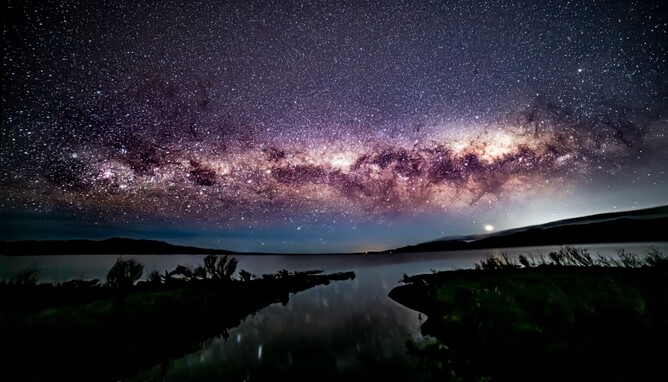Southern Wairarapa has been confirmed as the world’s newest Dark Sky Reserve known as the “gold standard” of dark sky places by a decision of the International Dark Sky Association (IDA).
Five years after deciding the pristine dark skies of the region should be preserved, protected and enhanced, Wairarapa Dark Sky Association has this week been granted formal Dark Sky Reserve recognition by the world body.
The decision underlines New Zealand as a world leader in dark sky development.
The first dark sky reserve established world-wide was Aoraki-McKenzie in the McKenzie Basin, and means Wairarapa is only the second in Aotearoa-New Zealand.
Other areas, including Rakiura/Stewart Island and Aotea/Great Barrier are designated dark sky sanctuaries by the IDA. Several other regional groups are also working for dark sky accreditation.
Recognition for the Wairarapa region comes five years after a small volunteer group set out to develop a dark sky reserve in South Wairarapa, based in Martinborough. Carterton and Masterton immediately sought to be included in the project.
The sky preservation has been boosted by widespread support from community groups, local iwi, astronomical societies in Wairarapa and Wellington, as well as buy-in from the region’s four local councils _ South Wairarapa, Carterton, Masterton and Greater Wellington Regional Council.
Government agencies Waka Kotahi (NZ Transport Agency), MaritimeNZ and the Department of Conservation have also provided significant support:
Waka Kotahi amended Wairarapa-wide street lighting plans to ensure all street lighting complies with IDA requirements;
MaritimeNZ added land-side shielding to its three local coastal lighthouses to help protect the night sky;
DOC enabled the project by changing exterior lights on its houses and huts in Aorangi Forest Park to comply with IDA rules _ and approved the southern Wairarapa forest as the “dark core” of the reserve.
The new reserve is surrounded by enduring protection from significant light encroachment, with the Pacific Ocean to the east and south, and the Remutaka and Tararua forest ranges to the west.
The IDA also noted a governance “first” created by the newly-approved application: a strong letter of support from a head of government, Prime Minister Jacinda Ardern.
Wairarapa Dark Sky Association chair Viv Napier praised the five-year effort by a small group of dedicated volunteers for the result.
“Their foresight and endeavours has produced something really special for the Wairarapa, ensuring the pristine night skies that perhaps many of us take for granted will be protected for future generations,” she said.
Napier was mayor of South Wairarapa District Council, based in Martinborough, when the idea of protecting the night skies first gained traction.
“There are also significant potential environmental and economic benefits, with our international status opening up huge opportunities for tourism,” she added.
Initial work on expanding the newly-minted Dark Sky Reserve to cover the Masterton region will begin in 2023.
The combined South Wairarapa and Carterton districts of the reserve cover an area of 3,665 square kilometres. With Masterton district added, the expanded reserve will encompass some 5,895 sq km.
And, hopefully, with no light spill or night-sky glare being generated from the whole region.
The whole project has strong historic links, Napier noted.
Polynesian explorer Kupe using the same night skies for navigation twice visited the southern Wairarapa Coast some 800 years ago. “Kupe’s Sail” rock today recognises his voyages using celestial navigation. Maori named the nearby Cape Palliser “Matakitaki-a-Kupe” the gazing of Kupe.
English explorer James Cook using the same celestial bodies _ visited the same coastal area in 1770, naming Palliser Bay (also known as Kawakawa Bay) after English Royal Navy Admiral Sir Hugh Palliser.
New Zealand’s first Comptroller of Customs, Stephen Carkeek, retired to a farm near Featherston and built New Zealand’s first private astronomical observatory in 1868. The Carkeek Observatory was listed as a Heritage 1 historic building and site in 2021 by HeritageNZ, following strong advocacy by Wairarapa Dark Sky Association.
Carter Observatory, New Zealand’s first National Observatory based in Wellington, was founded/funded by former Wairarapa – and Carterton – politician Charles Rooking Carter. The town is named after him.
The Wairarapa Dark Sky Association thanks all of those who have provided support for this community initiative: local and regional councils, the Prime Minister and local MP, regional Iwi, Department of Conservation, community groups, local businesses and sponsors.
